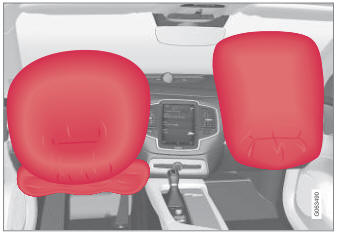Volvo XC90: Driver support / Adaptive Cruise Control standby mode
(Option/accessory.)
(Depending on market, this function can be either standard or optional.)
Adaptive Cruise Control (ACC1) can be deactivated and put in standby mode. This may happen automatically or be due to driver intervention.
Standby mode means that the function is selected in the instrument panel but not activated. In standby mode, Adaptive Cruise Control will not regulate speed or distance to the vehicle ahead.
Standby mode due to action by the driver
Adaptive Cruise Control will be deactivated and put in standby mode if any of the following occurs:
- The brakes are applied.
- The gear selector is moved to N.
- The vehicle is driven faster than the set speed for more than 1 minute.
Temporarily increasing speed using the accelerator pedal, e.g. when passing another vehicle, will not affect the setting. The vehicle will return to the set speed when the accelerator pedal is released.
WARNING
- If Adaptive Cruise Control is in standby mode, the driver must intervene and regulate both speed and distance to the vehicle ahead.
- If the vehicle comes too close to a vehicle ahead when Adaptive Cruise Control is in standby mode, the driver can be warned of the short distance by the Distance Alert* function.
Automatic standby mode
WARNING
With automatic standby mode, the driver is warned by an acoustic signal and a message on the instrument panel.
- The driver must then regulate vehicle speed, apply the brakes if necessary, and maintain a safe distance to other vehicles.
The function may automatically go into standby mode if one of the following occurs:
- One of the systems that Adaptive Cruise Control is dependent on stops working, such as Electronic Stability Control (ESC2).
- The driver opens the door.
- The driver unbuckles the seat belt.
- The engine speed (rpm) is too low/high.
- One or more of the wheels lose traction.
- The brake temperature is high.
- The parking brake is applied.
- The camera and radar unit is covered by snow or heavy rain (the camera lens/radar waves are blocked).
- Your vehicle's speed goes below 5 km/h (3 mph) and ACC cannot determine if the vehicle ahead is stationary or if it is another object, e.g. a speed bump.
- Your vehicle's speed goes below 5 km/h (3 mph) and the vehicle ahead turns so that ACC no longer has a vehicle to follow.
1 Adaptive Cruise Control
2 Electronic Stability Control
 Deactivating Adaptive Cruise Control
Deactivating Adaptive Cruise Control
(Depending on market, this function can be either standard or optional.)
Adaptive Cruise Control (ACC2) can be deactivated and switched
off.
Press the button on the steering
wheel (1)...
 Adaptive Cruise Control limitations
Adaptive Cruise Control limitations
(Option/accessory.)
Adaptive Cruise Control (ACC1) may have limited functionality in
certain situations.
Steep roads and/or heavy loads
Adaptive Cruise Control is primarily intended to be driven on flat roads...
Other information:
Volvo XC90 2015-2025 Owners Manual: Starting and stopping preconditioning. Preconditioning timer
(Option/accessory.) Preconditioning ventilates the passenger compartment, if possible, before driving. The function can be started in the center display or from a cellular phone. Starting and stopping from the vehicle Tap the symbol in the center of the climate bar to open Climate view in the center display...
Volvo XC90 2015-2025 Owners Manual: Software Updates
So that you as a Volvo customer shall have the best possible experience from your car, Volvo is continuously developing the systems in the cars and the services that you are offered. The software in your Volvo will be updated to the latest version when the vehicle is serviced at an authorized Volvo retailer...

